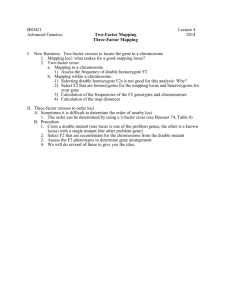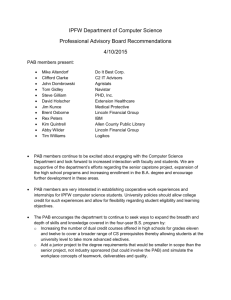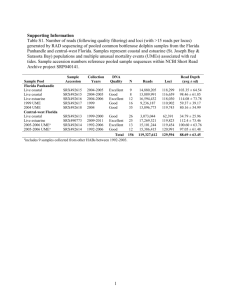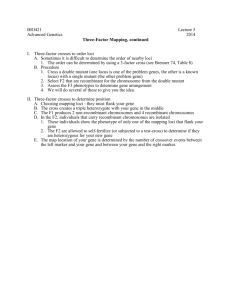4"30%Recita,on% DG%Lectures%19%&%20% QTLs%&%Human%Gene,cs% 1
advertisement
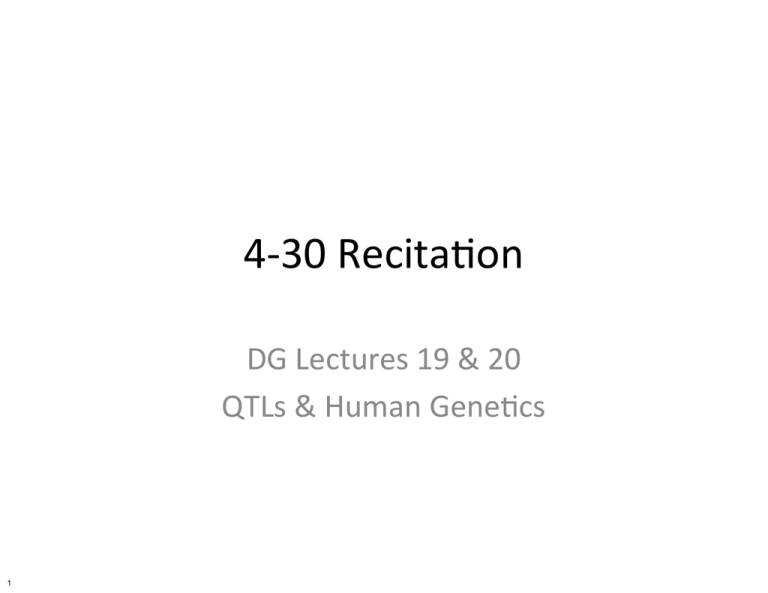
4"30%Recita,on%
DG%Lectures%19%&%20%
QTLs%&%Human%Gene,cs%
1
Announcements%
• Pset%5%due%this%Thursday%(5"1)%
• Exam%2%next%Tuesday%(5"6)%
– 2%double"sided%sheets%of%notes%
• Office%Hours%next%Monday%instead%of%Tuesday%
• No%recita,ons%or%regular%OHs%aVer%exam%
• Project%Presenta,ons%May%13%and%15%–%all%
students%will%peer%review%
2
Outline%
• Quan,ta,ve%Trait%Loci%
– Simple%gene,c%model%(haploid,%unlinked)%
– Genotype"phenotype%interac,ons%
• Broad"sense%and%narrow"sense%heritability,%sources%of%variance%
– LOD%scores%
– Bloom%et#al.#2013%&%missing%sources%of%heritability%
• Human%Gene,cs%
– Tes,ng%for%SNP/phenotype%associa,ons%
– Linkage%Disequilibrium%
– Variant%Phasing%
– Hardy"Weinberg%Equilibrium%
3
Genotype%to%Phenotype%
• Phenotype:%organisms%observable%characteris,cs%
or%traits%
– Qualita,ve:%dead/alive,%tall/short%
– Quan,ta,ve:%Growth%rate,%height,%gene%expression%
• Quan,ta,ve%Trait%locus%(loci)%–%a%marker%that%is%
associated%with%a%quan,ta,ve%trait%
– eQTL%(expression%quan,ta,ve%trait%locus)%–%marker%
associated%with%gene%expression%
– eQTLs%are%oVen%SNPs%(single%nucleo,de%
polymorphisms)%in%the%popula,on%
• Can%be%in%cis%(within%~Kbs%on%the%same%chromosome)%or%in%
trans%(1+Mb%away%or%on%different%chromosome)%
• OVen%cell"type%specific%
4
Haploid,%unlinked%gene,c%model%
•
•
•
•
N%loci%that%each%contribute%equally%(1/N)%to%the%trait%
+ + + + ++
+
+
Haploid%=%organism%has%1%copy%of%each%allele%
Unlinked%=%loci%are%on%different%chromosomes%or%far%enough%apart%on%the%same%
+
+ +
+
chromosome%so%crossing%over%(recombina,on)%can%always%occur%
– Each%locus%is%therefore%inherited%independently%
+
+
+
+
+
+
+
+ +
++
+ + + +
+
Child%randomly%inherits%maternal%or%paternal%copy%
+
1+
Effect+
Size+
2+ +
+
+
+
0+
+
+
+
0+
+
+
+
N++
+
0+
+
+
Binomial%model%of%#%of%black%
alleles%x%inherited:%
Here%x%is%the%phenotypic%
value%from%0%(no%alleles)%
to%1%(all%black%alleles)%
5
X+
+
+
+
1+
+
+
+
2+
+
+
1+
+
+
+
+
N+
!N$
p(x, N ) = # & (1−.5) N−x .5 x
"x %
+
+
1/N+
+
+
+ +
+
++N+
+
+
2+
+
1/N+
+
+
+
+
+
+
+
+
+
+
1/N+
+
+
+
+
+
+
+
Example+Ph
+
+
+Grow
+
+
+
+
+
E[x] = .5
σ = .25 / N
2
x
© cflm on wikipedia. Some rights reserved. License:
CC-BY-SA. This content is excluded from our Creative
Commons license. For more information, see
http://ocw.mit.edu/help/faq-fair-use/.
Situa,on%is%more%complex%if%loci%are%linked%
+
+ +
+
+
Gene(c+linkage+causes+marker+correla(on+
1+
1+
Proximal+
genomic+
loca(ons+makes+
crossing+over+
unlikely+during+
meiosis+
N\1+
1+
X+
1+
1+
1+
N\1+
N\1+
"%Assump,on%that%each%allele%is%inherited%independently%no%longer%
holds%–%models%more%complex%than%binomial%needed%to%capture%this%
dependence%
6
+
+ +
+ + +
+
+
+ +
+ +
+ +
+
+
+
Genotype%–%Phenotype%interac,ons%
+ +
+
+ +
+
+
+
+
+
+ +
+ +
+ +
+ + i
+
i
+
+ +
+
+
+
i
++
+ +
p = f ( g+i ) + ei
E [ ei ] = 0
7
+
+
• + + i+–+individual+in+[1+..+N]+
+ + + ++ +
+ + + +
+ ++ + ++ + ++ +
+
+ +
++ + +
• gi+–+genotype+of+individual+i+
+ ++ +
+ + +
++ + +
++
+
+
+
+
+• ++ +pi+–+quan(ta(ve+phenotype+of+individual+i+(single+trait)+
+
+ + + + + ++
+
+
+
++
+
+
+
+
+ + +
+ + • e +–+environmental+contribu(on+to+p
+ + + + ++
+
+
+
+ +
+ + +
+ + +
+ +
+
++ +
++
+ + +
E !"e 2#$ = σ e2
2
2
2
=
+
+
2
σ+ + + σ g + σ++ e+ + + σ ge
2
+p + +
+ +
+ +
+
+
Phenotype%is%a%func,on%of%genotype%plus%
an%environmental%component%
Environmental%component%is%unbiased%but%
introduces%noise%from%genotype%to%phenotype%
+
+
+
!%
+
2
p
2
g
σ = σ +σ
Assume%environment%affects%all%genotypes%equally%">%g%
and%e%are%independent%and%their%covariance%is%0%
+
+
+
2
e
+
+
All%phenotypic%varia,on%
Environmental%
varia,on%
Heritable%gene,c%varia,on%
(Broad"sense%heritability%H2)%
Addi,ve%gene,c%
varia,on%
(Narrow"sense%
heritability%h2)%
Dominance%
effects%
8
Non"addi,ve%
gene,c%varia,on%
Gene"gene%
interac,ons%
Gene"
environment%
interac,ons%
+
+ +
+
2%types%of%heritability%
++
+
+
• Broad"sense%(H2)%and%narrow"sense%(h2)%
+ +
+
• Broad"sense%
+
+ +
+
– Frac,on%of%phenotypic%variance%explained%by%gene,c%
components%
Can%be%es,mated%from%
2
2
2
σ
σ
g
p −σ e
H = 2=
2
σp
σp
2
iden,cal%twins%or%clones%
Can%be%observed%from%all%
individuals%in%popula,on%
– The%upper%bound%for%phenotypic%predic,on%by%op,mal%
++
+
+
+ +
+
+
arbitrary%(not%necessarily%linear)%model%
• Narrow"sense%+
– The%upper%bound%for%phenotypic%predic,on%by%linear%
model%(=%frac,on%of%total%phenotypic%variance%that%is%
caused%by%the%addi,ve%effects%of%genes)%
– Determines%the%resemblance%of%offspring%to%their%parents%
and%the%popula,on’s%evolu,onary%response%to%selec,on%
9
+++
Narrow"sense%heritability%(h2)%is%the%
regression%(slope)%of%offspring%on%parents%
h2 §
h2 §ñ
offspring
offspring
offspring
parents
h2 §
parents
parents
© source unknown. All rights reserved. This content is excluded from our Creative
Commons license. For more information, see http://ocw.mit.edu/help/faq-fair-use/.
" Regression%slope%is:%Cov(x,y)/Variance(x)%or%Cov(parents,%offspring)/Variance(parents)%
" x%is%the%“mid"parent”%
" The%higher%the%slope,%the%bener%the%offspring%resemble%their%parents.%
" In%other%words,%the%higher%the%heritability,%the%bener%the%offspring%trait%values%are%predicted%
by%parental%trait%values.%
hnp://content.csbs.utah.edu/~rogers/ant5221/lecture/QTs2.pdf%
10
Narrow"sense%heritability:%
)
) )
addi,ve%model%of%phenotype%
+
+ +
+
)
+
+ +
+
• gi,j%is%a%binary%{0,1}%variable%of%QTL%j%in%individual%i%
• Each%QTL%in%the%genotype%contributes%independently%&%
)
)
linearly%to%the%phenotype:%
)
f a ( gi ) = ∑ β j gij + β 0
j∈QTL
• βj%is%the%effect%of%QTL%j%on%the%phenotype%(higher%">%QTL%
has%greater%impact)%
+
+ +
• For%addi,ve%markers,%children%are%expected%to%be%the%+ +
+
+ +
midpoint%of%their%parents%since%they%get%an%average%of%½%
+ + +
loci%from%each%parent:%
f (p ) f (p )
E !" f a ( gi )#$ =
11
a
2
1
+
a
2
+
+
+
2
+
))
)
)
)
Narrow"sense%heritability:%
)) ))
) ) ) )
) )
+ +
+
)+
) )+ + +
)
addi,ve%model%of%phenotype%
+
+ +
+
+
+ +
+
+
+ +
+ + + + +
+
+
+ ++ ++
+ +
+
+
+ + ++ +
+ + ++
+ +
+
+
++ + + + + + + + + + + +
+ + + +
+ + f + g ++ =+ + ∑+ + β g++ +++β + + ++ +
+
+
a (+ i )+ + + + ++
j + ij+ + + 0 +
+
+
+
j∈QTL
+ +
+
+
p i = f a ( g i ) + ei
Narrow"sense%
heritability:%
12
+
+
+
+ ++ +
++
+
+ ++
+ + +
+
Addi,ve%gene,c%
variance%
2
σ
a
h = 2
σp
2
+
+
+ +
+
N
2
1
2
2
σ a = σ p − ∑ pi− f a(+ gi)+ +
N i=1
+ +
(
)
+
+
+
+
+ +
+ + +
Total%phenotypic% Variance%that%remains%
aVer%linear%model%–%one%
variance%
source%of%“missing”%
heritability%in%studies%
)
) )
)
)
Using%LOD%scores%to%discover%QTLs%for%
a%trait%(e.g.%gene%expression)%
P
+
LOD
=
∏
log
10
+
LOD%=%Logarithm%of%the%ODds#
N
i=1
( p | g , µ , µ ,σ )
i
ij
0
1
P ( pi | µ, σ )
i%=%individual%
%
+
+
+
+ +
++ +
+ i% +
“Null”%model:%locus%does%not%affect%gene’s%expression,%and%the%probability%of%expression%value%p
+
+ +
+ +
+ +
++ + +
+
simply%follows%a%Normal(μ,σ2)%distribu,on%
%
+
+
+
+
+
+
+
+
“Alterna,ve”%model:%locus%affects%a%gene’s%expression%(is%a%QTL),%and%there%are%different%mean%
+
+
+
+
+
expression%values%μ0%and%μ1%depending%on%which%genotype%is%present%at%the%locus%(if%gij=0%or%1)%
%
+
+
+
+
+
+
+ +
+
" If%the%alterna,ve%model%(that%the%locus%is%a%QTL%for%the%gene)%doesn’t%explain%the%expression%
+ +
+ +
+
+
+ +
+
values%any%bener%than%the%null%model,%the%probability%ra,os%are%1%and%the%LOD%score%is%0%
+
" If%alterna,ve%model%bener%explains%the%data,%LOD%score%>%0%
" If%the%locus%is%a%QTL,%the%LOD%score%will%get%higher%with%increasing%number%of%individuals%(N)%–%
+
+
+ +
+
+
with%larger%sample%samples%we%have%greater%power%to%detect%loci%as%being%sta,s,cally%
+
+
+
+
+
+
+
significant%QTLs.%This%is%referred%to%as%“power”%–%a%study%with%too%few%people%to%determine%
+
sta,s,cal%significance%at%some%loci%is%“underpowered”.%
13
)
) )
)
)
Using%LOD%scores%to%discover%QTLs%for%
a%trait%(e.g.%gene%expression)%
N
LOD = log10 ∏
+
+
P ( pi | gij, µ 0, µ 1, σ )
P ( pi | µ, σ )
i=1
• How%to%determine%if%a%LOD%score%is%significant?%
+
+
+
+ +
++ +
+
" Permute%genotypes%(so%the%marker%g
+
+ ij%and%expression%values%are%mixed%up)%1000%
+
+ +
+ +
++ + +
,mes%and%compute%LOD%scores%to%get%empirical%null%distribu,on%
+
+
+
+
+
+
+
" Determine%the%null%LOD%score%that%corresponds%to%FDR%=%0.05%
" Use%this%threshold%on%unpermuted%LOD%scores%to%find%QTLs%for%each%gene%
+
+
+
+
+
" Since%all%loci%are%included%in%the%permuted%null%distribu,on,%no%mul,ple%hypothesis%
correc,on%needed%+
+
+
+
+
+
+ +
+
+
+
+
+
+
+
+ +
• Fit%a%linear%model%to%discovered%QTLs%to%determine%each%QTL’s%contribu,on%(β
j)%
+
14
+
+
+
+ +
+
+
" Once%this%has%been%done%to%find%the%set%of%sta,s,cally%significant%QTLs%from%the%first%
pass,%you%can%repeat%to%find%QTLs%in%the%residuals%from%the%exis,ng%model%that%may%have%
+
+
+
+
+
+
+
been%below%the%threshold%in%the%first%pass%(3%,mes)%
+
%
+
+
+
Bloom%et%al.%2013:%“Finding%the%sources%of%missing%
+ +
+
+
heritability%in%a%yeast%cross”%
+
)
)
)
)
)
)
• 5"29%QTLs%per%trait%(median%of%12),%although%most%QTLs%have%
small%effect%size%
+
+
+ +
+ +
+
+
+
+
+
+ + +
Absolute%value%of%normalized%
difference%in%means%between%
Courtesy of Macmillan Publishers Limited. Used with permission.
genotypes%
Source: Bloom, Joshua S., Ian M. Ehrenreich, et al. "Finding the Sources of
15
Missing Heritability in a Yeast Cross." Nature 494, no. 7436 (2013): 234-7.
+
Bloom%et%al.%2013:%“Finding%the%sources%of%missing%
+
+ +
+
heritability%in%a%yeast%cross”%
)
)
)
)
)
• Good%news:%most%addi,ve%heritability%(narrow"sense)%is%
explained%by%detected%QTLs%
+
+ +
+
)
+
+
+ + +
Courtesy of Macmillan Publishers Limited. Used with permission.
Source: Bloom, Joshua S., Ian M. Ehrenreich, et al. "Finding the Sources of
Missing Heritability in a Yeast Cross." Nature 494, no. 7436 (2013): 234-7.
16
+
+
Bloom%et%al.%2013:%“Finding%the%sources%of%missing%
heritability%in%a%yeast%cross”%
+
+ +
+
+
• Bad%news:%There%is%s,ll%much%heritability%missing%from%our%
)
)
)
) )
)
addi,ve%linear%model%
+
+
17
+
)
+
+
+ + +
++
Courtesy of Macmillan Publishers Limited. Used with permission.
Source: Bloom, Joshua S., Ian M. Ehrenreich, et al. "Finding the Sources of
Missing Heritability in a Yeast Cross." Nature 494, no. 7436 (2013): 234-7.
+
Bloom%et%al.%2013:%“Finding%the%sources%of%missing%
heritability%in%a%yeast%cross”%
• What%could%cause%the%missing%heritability?%
– Incorrect%heritability%es,mates%
– Rare%variants%that%the%study%is%underpowered%to%detect%
– Structural%variants%(inser,ons%or%dele,ons%–%these%studies%typically%only%
measure%SNPs)%
– Epigene,c%interac,ons%
– Epista,c%effects%
• When%the%effect%of%a%gene%depends%on%the%presence%of%one%or%more%modifier%genes%(the%
gene,c%background)%
• Example:%locus%A%and%locus%B%each%only%cause%a%5%%decrease%if%one%of%the%variants%is%
present,%but%a%50%%decrease%if%both%are%present%
• Since%all%pairwise%interac,ons%is%too%large%of%a%search%space%(100,000%x%100,000),%can%only%
consider%all%interac,ons%that%involve%at%least%of%the%detected%QTLs%(20%x%100,000)%
18
Human%Gene,cs%
• We%want%to%find%human%variants%(SNPs,%etc.)%that%are%
associated%with%a%par,cular%phenotype%(e.g.%a%disease)%
“Manhanan%plot”%
%
hnp://www.nature.com/ng/journal/v44/n4/
images/ng.1109"F1.jpg%
Courtesy of Macmillan Publishers Limited. Used with permission.
Source: Tanikawa, Chizu, Yuji Urabe, et al. "A Genome-wide Association
Study Identifies Two Susceptibility Loci for Duodenal Ulcer in the Japanese
Population." Nature Genetics 44, no. 4 (2012): 430-4.
• We%need%a%way%to%test%whether%a%SNP%is%significantly%
associated%with%a%phenotype:%
– Chi"squared%test%
• Asympto,c%approxima,on,%so%not%appropriate%if%counts%are%small%(should%be%at%
least%5%counts%per%category)%
– Fisher's%exact%test%
• An%“exact”%calcula,on%(not%asympto,c%approxima,on),%but%involved%factorials%
so%computa,onally%difficult%when%counts%become%large%(but%this%is%exactly%
when%the%Chi"square%test%is%appropriate)%
19
Tes,ng%for%SNP/phenotype%associa,on%
• Tes,ng%for%associa,on%between%a%SNP%and%a%disease%(or%
some%other%trait)%–%we%are%given%the%following%counts:%
Allele%
Cases,
Controls,
Total%Counts%
C,
62%
80%
142%
A,
108%
250%
358%
Total%Counts%
170%
330%
500%
• Calculate%expected%counts%under%null%hypothesis%that%the%propor,on/
ra,o%of%cases%to%controls%is%the%same%regardless%of%whether%an%
individual%is%C%or%A:%
– 1)%%calculate%total%propor,on%of%cases%regardless%of%A/C%=%170/500%=%0.34%
– 2)%%calculate%what%propor,on%of%the%142%Cs%should%be%cases%according%to%the%total%
propor,on%of%cases%=%142(0.34)%=%48.28,%controls,=%142(1"0.34)%=%93.72%
– 3)%%same%for%the%As:%%what%propor,on%of%the%358%As%should%be%cases/controls%
according%to%null%model?%
for%A%individuals,%expected%cases%=%358(0.34)%=%121.72,%controls,=%358(1"0.34)=236.28%%
20
Tes,ng%for%SNP/phenotype%associa,on%
• Tes,ng%for%associa,on%between%a%SNP%and%a%disease%(or%
some%other%trait)%–%we%are%given%the%following%counts:%
Observed,
Allele%
Cases,
Controls,
Total%Counts%
C,
62%
80%
142%
A,
108%
250%
358%
Total%Counts%
170%
330%
500%
Allele%
Cases,
Controls,
Total%Counts%
C,
48.28%
93.72%
142%
121.72%
236.28%
358%
170%
330%
500%
Expected,
Using%a%
A,
Chi"squared%
Total%Counts%
test:%
(Oi − Ei )2 (62 − 48.28)2 (80 − 93.72)2 (108 −121.72)2 (250 − 236.28)2
X =∑
=
+
+
+
= 8.25
Ei
48.28
93.72
121.72
236.28
i=1
2
n
df%=%(#%rows%"1)(#%cols%–%1)%=%1#
21
Tes,ng%for%SNP/phenotype%associa,on%
Chi-Square Distribution Table
hnp://sites.stat.psu.edu/~mga/401/
tables/Chi"square"table.pdf%
0
Since%our%sta,s,c%(8.25)%is%
higher%than%the%cut"off%for%
P%=%0.005,%the%P"value%is%
less%than%0.005%
χ2
The shaded area is equal to Æ for ¬2 = ¬2Æ .
Using%a%
Chi"squared%
test:%
df
¬2.995
¬2.990
¬2.975
¬2.950
¬2.900
¬2.100
¬2.050
¬2.025
¬2.010
¬2.005
1
2
3
4
5
6
7
8
9
10
0.000
0.010
0.072
0.207
0.412
0.676
0.989
1.344
1.735
2.156
0.000
0.020
0.115
0.297
0.554
0.872
1.239
1.646
2.088
2.558
0.001
0.051
0.216
0.484
0.831
1.237
1.690
2.180
2.700
3.247
0.004
0.103
0.352
0.711
1.145
1.635
2.167
2.733
3.325
3.940
0.016
0.211
0.584
1.064
1.610
2.204
2.833
3.490
4.168
4.865
2.706
4.605
6.251
7.779
9.236
10.645
12.017
13.362
14.684
15.987
3.841
5.991
7.815
9.488
11.070
12.592
14.067
15.507
16.919
18.307
5.024
7.378
9.348
11.143
12.833
14.449
16.013
17.535
19.023
20.483
6.635
9.210
11.345
13.277
15.086
16.812
18.475
20.090
21.666
23.209
7.879
10.597
12.838
14.860
16.750
18.548
20.278
21.955
23.589
25.188
(Oi − Ei )2 (62 − 48.28)2 (80 − 93.72)2 (108 −121.72)2 (250 − 236.28)2
X =∑
=
+
+
+
= 8.25
Ei
48.28
93.72
121.72
236.28
i=1
2
22
n
df%=%(#%rows%"1)(#%cols%–%1)%=%1#,%and% P(X% 12 ≥ 8.25)
%
%= 0.0041
%
%so%we%reject%H0%(=>SNP%is%associated)#
%
Tes,ng%for%SNP/phenotype%associa,on%
• Tes,ng%for%associa,on%between%a%SNP%and%a%disease%(or%
some%other%trait)%–%we%are%given%the%following%counts:%
Observed,
+
+ +
C,+
+
Cases,
Allele%
+
(
(
(
(
(
((
A,
(
(
(
(
+ +
+62% +
(
(
(
(
Total%Counts%
(
(
(
108%
(
(
(
170%
(
Fisher’s%Exact%Test:%
! a + b $! c + d $
##
&&##
&&
a
c
"
%"
%
p=
! a+b+c+d $
##
&&
a
+
c
"
%
++
Total%Counts%
80%
142%
250%
358%
330%
500%
(
Upper"tail%one"sided%P"value:%
Sum+all+probabili(es+for+observed+and+all+more+extreme+values+with+same+
marginal+totals+to+compute+probability+of+null+hypothesis++
a
Let%our%1%degree%of%freedom%be%%%%%,%
the%number%of%cases%with%“C”%
23
+
Controls,
142
X
a=62
�142��
358
a
170 a
�500
�
170
�
⇡ .003
a
Since%the%expected%count%of%%%%%(=%Cases%with%C)%
was%~48,%since%62%=%48%+%14,%the%lower%tail%goes%
up%to%48%"%14%=%34.%The%two"sided%P"value%is:%
34
X
a=0
�142��
358
a
170 a
�500
�
170
�
+
142
X
a=62
�142��
358
a
170 a
�500
�
170
�
⇡ .0047
Human%Gene,cs%
AVer%doing%a%Chi"square%test%and%seeing%that%a%SNP%is%significantly%enriched%in%a%
disease%popula,on,%we%might%believe%that%the%SNP%is%linked%to%the%disease.%%But%
popula,on%structure%can%confound%these%results%(methods%for%correc,ng%for%
this%are%beyond%the%scope%of%this%class)%
Test%control%SNPs%(known%to%
=%normal%
=%disease%
A%
A%
A%
A%
muta,on%
causing%disease%
at%locus%2%
A%
A%
A%
A%
A%
be%unrelated%to%the%disease)%
A%or%T%=%SNP%at% for%high%X2%distribu,on%
between%cases%and%controls,%
Locus%1%
A%
which%would%indicate%
popula,on%stra,fica,on%
A%
A%
A%
A%
A%
A%
benign%
muta,on%
A%">%T%at%
locus%1%
A%
T%
T%
T%
T%
A%
A%
T%
A%
A%
In%4th%genera,on,%frac,on%of%Ts%in%popula,on%=%4/14,%but%in%diseased%group%=%4/6%
But%once%we%see%the%family%tree,%we%see%that%the%SNP%at%locus%1%is%unrelated%to%the%disease%
24
A%
Linkage%Disequilibrium%
• Recombina,on%during%meiosis%"shuffles"%alleles%between%the%
homologous%maternal%and%paternal%chromosomes%
Over%,me%and%aVer%many%crossover%events%have%occurred,%loci%that%are%physically%close%
together%on%the%chromosome%will%tend%to%remain%together,%so%the%probability%of%two%
loci%occurring%together%is%a%func,on%of%their%distance%along%the%chromosome%
AB
C
If%a%crossover%event%is%equally%likely%to%occur%at%
any%posi,on%along%the%chromosome,%the%
probability%that%it%will%separate%loci%A%and%B%is%
much%smaller%than%A%and%C%or%B%and%C%
We%have%so%far%generally%assumed%that%inheri,ng%a%par,cular%allele%at%one%locus%won't%affect%
the%probability%of%inheri,ng%an%allele%at%a%different%locus.%%Such%loci%are%in%linkage%
equilibrium.%
%
Loci%are%considered%in%linkage%disequilibrium%if%genotypes%at%two%loci%are%not%independent%of%
one%another%(e.g.%inheri,ng%A%at%locus%1%influences%probability%of%inheri,ng%B%at%locus%2)%
25
Linkage%Disequilibrium%
• Measuring%linkage%disequilibrium:%%consider%two%loci%A%
and%B,%where%locus%A%has%two%possible%alleles%A%and%a,%
and%locus%B%has%two%alleles%B%and%b:%
– then%gametes%can%have%one%of%four%possible%combina,ons:%
Gamete%
Frequency%
Allele%
Frequency%
AB%
pAB%
A%
pA=pAB+pAb%
Ab%
pAb%
a%
pa=paB+pab%
aB%
paB%
B%
pB=paB+pAB%
ab%
pab%
b%
pb=pab+pAb%
• Then%if%alleles%are%randomly%associated%w/%one%another,%the%
frequencies%of%the%four%gametes%should%be%the%product%of%the%
allele%frequencies:%
hnp://www.nature.com/nrg/
– ex.%pAB%=%pApB%=%(pAB+pAb)(paB+pAB)%
journal/v2/n1/pdf/
Equilibrium
AB
ab
ab
Ab
aB
Ab
ab aB
Ab
AB Ab AB
AB
aB ab
aB
nrg0101_011a.pdf%
Courtesy of Macmillan Publishers Limited. Used with permission.
Source: Mackay, Trudy FC. "Quantitative Trait Loci in Drosophila."
Nature Reviews Genetics 2, no. 1 (2001): 11-20.
26
Linkage%Disequilibrium%
Gamete%
Frequency%
Allele%
Frequency%
AB%
pAB%
A%
pA=pAB+pAb%
Ab%
pAb%
a%
pa=paB+pab%
aB%
paB%
B%
pB=paB+pAB%
ab%
pab%
b%
pb=pab+pAb%
• If%they%are%not%randomly%associated%(and%therefore%in%linkage%
disequilibrium)%then%there%will%be%a%devia,on%(D)%in%the%expected%
frequencies:%
Disequilibrium
–
–
–
–
pAB%=%pApB%+D%
pAb%=%pApb%"%D%
paB%=%papB%"%D%
pab%=%papb%+%D%
• Where%D%is%given%by:%
AB
ab
AB
ab
ab
AB ab
AB
ab
ab
AB
AB
hnp://www.nature.com/nrg/
journal/v2/n1/pdf/
nrg0101_011a.pdf%
ab
ab AB
Courtesy of Macmillan Publishers Limited. Used with permission.
Source: Mackay, Trudy FC. "Quantitative Trait Loci in Drosophila."
Nature Reviews Genetics 2, no. 1 (2001): 11-20.
– D%=%pABpab%–%pAbpaB%%(D%=%0%=>%no%disequilibrium)%
27
AB
• AB%and%ab%are%the%"coupling"%gametes%(AB%on%one%parental%
chromosome,%ab%on%the%other),%Ab%and%aB%are%the%"repulsion"%
gametes%(crossing%over%event%must%occur%between%the%loci)%–%D%is%
the%difference%between%these%types.%
Variant%Phasing%
•
•
•
To%determine%which%genes%are%linked%together%(and%therefore%likely%to%be%inherited%
together%in%the%next%genera,on),%you%need%to%figure%out%which%alleles%(which%
variant%SNPs)%are%on%the%same%chromosome%=%"phasing"%%
– Why%does%this%maner?%
%"%If%you%have%2%different%muta,ons%in%the%same%copy%of%a%gene%(phased),%the%2nd%copy%(no%
muta,ons)%may%be%enough%for%normal%ac,vity%
%"%If%there’s%one%muta,on%in%each%(unphased),%both%copies%of%the%gene%may%be%nonfunc,onal%
OVen%rely%on%family%data%(e.g.%parents)%to%determine%which%"parental"%
chromosome%segments%were%inherited%together%in%the%child%
Can%be%used%to%iden,fy%haplotypes%=%combina,ons%of%alleles%at%adjacent%loca,ons%
in%a%chromosome%that%are%inherited%together%over%many%genera,ons%
hnp://www.uic.edu/classes/bios/bios100/lecturesf04am/
crossingover01.jpg%
X,%Y,%and%Z%are%
“in%phase”%on%this%
chromosome%
x,%y,%and%z%are%“in%phase”%on%
this%chromosome%
Due%to%crossing%over,%the%
phasing%has%changed%
© The McGraw Hill Corportation, Inc.. All rights reserved. This content is excluded from our
Creative Commons license. For more information, see http://ocw.mit.edu/help/faq-fair-use/.
28
Variant%Phasing%
Longer%reads%will%help%–%
two%SNPs%present%in%the%
same%read%are%definitely%on%
the%same%chromosome%
29
Hardy"Weinberg%Equilibrium%(HWE)%
• Assume%only%two%alleles:%%A%and%a%
• If%P(A)%=%ψ%=%frequency%of%A%in%the%popula,on,%
and%the%popula,on%is%in%HWE,%then:%
– P(AA)%=%ψ2%
– P(Aa)%=%2ψ(1"ψ)%
– P(aa)%=%(1"ψ)2%
gamete,
A%(ψ)%
a%(1"ψ)%
A%(ψ)%
AA%(ψ2)%
Aa%(ψ(1"ψ))%
a%(1"ψ)%
Aa%(ψ(1"ψ))% aa%((1"ψ)2)%
• HWE%states%that%allele%and%genotype%frequencies%
in%a%popula,on%will%be%constant%from%genera,on%
to%genera,on%in%the%absence%of%other%
evolu,onary%forces;%assuming%the%following:%
– random%ma,ng%
– popula,on%size%is%infinite%
– no%migra,on,%muta,on%or%selec,on%(so%allele%
frequencies%won't%change)%
30
HWE%and%Likelihood%ra,o%tests%
• Tes,ng%whether%a%popula,on%is%in%HWE%using%a%
likelihood%ra,o%test%(LRT):%
– say%we%observe%N%=%200%individuals%with%the%following%
genotypes:%%25%aa,%90%Aa,%85%AA%
– is%this%popula,on%in%HWE?%
• Recall%that%the%likelihood%ra,o%is%given%by:%
P(Data | H 0 )
λ=
P(Data | H1 )
likelihood%of%the%data%under%the%null%model%
likelihood%of%the%data%under%the%alterna,ve%
model%
• Then%the%following%test%sta,s,c%is%approximately%Chi"
square%distributed:%
−2 ln(λ ) ~ X df2
– df%=%(#%free%parameters%in%H1)%–%(#%free%parameters%in%H0)%
31
HWE%and%Likelihood%ra,o%tests%
• We%observe%n%=%200%individuals%with%the%following%
genotypes:%%25%aa,%55%Aa,%120,AA%
– is%this%popula,on%in%HWE?%
• Here,%under%the%unconstrained%model%H1,%the%
parameters%are%pAA,%pAa%and%paa%(df%=%2)%
– for%this%example:%%%pAA%=%120/200%=%0.6,%pAa%=%55/200%=%
0.275,%paa%=%25/200%=%0.125%
• Under%the%constrained%model%H0,%we%only%need%pA%
(frac,on%of%A%alleles%in%popula,on)%and%if%HWE%holds:%
– pA%=%(2nAA+nAa)/2n#=%(2(120)%+%55)/400%=%295/400%=%0.7375#
– pAA%=%(pA)2%=%(0.7375)2%=%0.5439%
could%also%do%a%Chi"square%
– pAa%=%2pA%(1"pA)%=%0.3872%
goodness%of%fit%test%with%these%
– paa%=%(1"pA)2%=%0.0689%
probabili,es%*%n%as%the%expected%
counts%instead%of%LRT%
32
HWE%and%Likelihood%ra,o%tests%
• We%observe%N%=%200%individuals%with%the%following%
genotypes:%%25%aa,%90%Aa,%85%AA%
– is%this%popula,on%in%HWE?%
• Therefore,%our%test%sta,s,c%is:%
P(Data | pA2 , 2 pA (1− pA ), (1− pA )2 )
−2 ln(λ ) = −2 ln
P(Data | pAA , pAa , paa )
= −2 ln
P(Data | 0.5439, 0.3872, 0.0689)
P(Data | 0.6, 0.275, 0.125)
• Note%that%P(Data|H)%follows%a%mul,nomial%distribu,on%
(generalized%binomial%for%more%than%2%categories):% Note%that%the%
P(x1,..., xk ;n, p1,..., pk ) =
So%for%example:%
n!
p1x1 ... pkxk
x1 !,..., xk !
P(Data | H1 ) = P(25, 90,85;200, 0.6, 0.275, 0.125) =
33
factorials%will%drop%
out%of%LRT%
200!
0.6 250.27590 0.12585
25!90!85!
Likelihood%Ra,o%Tests%
• Can%use%a%similar%LRT%to%determine%whether%the%data%
are%bener%explained%when%treated%as%two%
subpopula,ons,%like%cases%and%controls:%
– H0:%%pAA,%pAa%and%paa%are%sufficient%to%explain%the%data%
– H1:%%we%do%bener%by%considering%two%subpopula,ons:%
• p1AA,%p1Aa%and%p1aa%for%subpopula,on%1%(D1)%
• p2AA,%p2Aa%and%p2aa%for%subpopula,on%2%(D2)%
• Then%our%test%sta,s,c%T%is:%
P(D | pAA , pAa , paa )
T = −2 ln
2
2
2
P(D1 | p1AA , p1Aa , p1aa )P(D 2 | pAA
, pAa
, paa
)
– approx.%Chi"square%distributed%with%df%=%4%–%2%=%2%
34
MIT OpenCourseWare
http://ocw.mit.edu
7.91J / 20.490J / 20.390J / 7.36J / 6.802J / 6.874J / HST.506J Foundations of Computational and Systems Biology
Spring 2014
For information about citing these materials or our Terms of Use, visit: http://ocw.mit.edu/terms.
